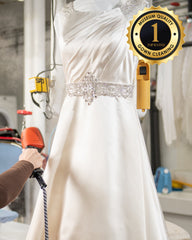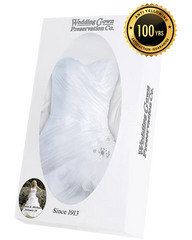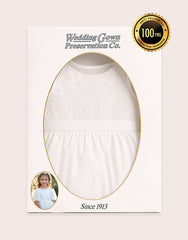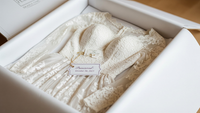It might tug at your heartstrings a little, but after your big day has come and gone, your gorgeous gown will eventually need to find its way into a wedding dress box for safekeeping.
Actually, you don’t have to. Some brides choose to donate or public sale off their dress, others trash it in a “trash my dress” picture shoot, some frame their wedding gown and others personalize it to create a completely new outfit. The possibilities truly are endless!
Others have their gowns, veil and different accessories professionally cleaned and preserved. If you want to store your robe yourself, first have your wedding dress dry cleaned (as soon after your event as possible) and then choose the wedding dress preservation box options for the exceptional results.
Now, if you're one of those brides who just can't bear the thought of saying goodbye to your dress for good, you'll want to know how to keep it looking as fabulous as it did on your wedding day. Preserving your gown so it stays picture-perfect for years to come is a bit of an art. Before you decide not to preserve it, you should know the risks of skipping this step, like that dreaded yellowing that can happen over time. Trust me, you'll want to keep that stunning while gown just as bright as the day you wore it!
What Makes Fabric Yellow Over Time?
Chemical Degradation:
So, why does your white wedding dress turns yellow over time? the simple answer is that it's all about the chemistry. As the original fibres in the fabric start to break down, the colorless chemicals with them begin to age, turning that crisp white into a not-so-charming shade of yellow. It's just one of those unavoidable things that happen over time.
Environmental Factors
Your gown's fibers can break down faster than you might think, thanks to environmental facts like direct sunlight, high humidity, or too much heat. Sure, these things can speed up the ageing process, but believe it or not, there are other culprits when it comes to your wedding gowns turning yellow. There are other, sneakier reasons behind that color change.
Atmospheric pollution
Believe it or not, air pollution can be a major player in turning your wedding dress yellow, especially when nitrogen is involved. The gunk in the air can actually react with the fabric and change its color. That's why it's important to store your dress in a clean and well-ventilated place.
Transferred contaminants
Did you know your dress can pick up unwanted friends while in storage? Transferred contaminants can latch onto your gown, whether it's before or after you buy it. For years, it's been well-known that those plastic bags, like the ones made of polyethene, can cause your dress to yellow, something called "phenolic yellowing." Things like plastic bags, cardboard, and even some papers can release chemicals damaging the fabric.
Wedding Day Stains
Throughout your wedding day, your dress goes through a lot! From the dance floor grime and body lotion to grass stains from that gorgeous outdoor photoshoot, not to mention wine spills, cake smudges, perfume, and all that dancing sweat, a top-notch wedding dress cleaning service can help you keep those memories close to your heart (and off your gown) before it gets tucked away for safekeeping.
How To Prevent Wedding Dress From Yellowing
Know You Gown
Prevention is the first step to avoid yellowing in your wedding gown. Have your wedding dress dry-cleaned at once after use. Contact an authentic dry cleaner you previously trusted and prearrange details for cleaning. Tell the cleaner what sorts of fabric have been used to make the garment, and, if possible, request that the cleaner get rid of metallic buttons, which can oxidize and rust during storage.
Timely Dry Cleaning for Best Results
Take the gown to your dry cleaner within 24 hours of wear; if this is not possible, arrange for a responsible person to take the robe to your dry cleaner. The longer dirty materials remain untreated, the harder it will be for your dry-cleaner to dispose of them. Stains may also no longer be immediately apparent in the gown. Alcoholic liquids and physique oils can dry clear; however, they will turn brown or yellow over time.
Preparing Your Wedding Gown for Storage
Acid-Free Storage
Request that your dry cleaner prepare the wedding gown for storage. Most dry cleaners have access to acid free boxes for wedding dresses and acid-free tissue paper. If your desired dry cleaner does not provide this service, you can also prepare the gown for storage yourself.
Proper Storage Techniques
Line the acid-free garment storage container with acid-free tissue paper. Gently lay the gown flat in the box. Wrap the gown in tissue paper, putting the paper in the sleeves and any crevices to stop fabric-on-fabric friction. Store your garment in a cool, dry space. Keep your garment in a dimly lit or dark space; light can cause natural fibers to yellow.
Regular Inspections
Wedding gown storage requires periodic garment checks. Remove your garment from storage once per year. Carefully examine the robe for signs of age, mildew, holes, stains, and discoloration. Have all damages repaired by a professional dry cleaner.
Wedding Dress Preservation Methods
Sealed Wedding Dress Preservation
The reason wedding gowns have been sealed in boxes is that sealed boxes protect them from oxygen and keep them from yellowing. However, keeping oxygen from getting in the protection box is almost impossible. A sealed wedding ceremony gown is in increased danger of permanent creasing, mold, mildew, and oxidized stains. And if your wedding gown is sealed, you cannot look at it periodically (as recommended with the aid of fabric conservationists).
Boxed Wedding Dress Preservation
Boxed wedding dress preservation is very similar to sealing but has some quintessential differences. Like the sealing, your wedding dress will be cleaned and pressed, and then folded into a wedding gown protection box. Acid-free tissue is also used for buffering folds. However, in contrast to sealing, the preservation box is no longer sealed, and you are inspired to check out your wedding gown occasionally.
Because the wedding dress preservation box is not sealed, your wedding gown fabric can breathe. You can refold your wedding gown periodically, protecting it from permanent creases.
Choosing the Right Wedding Dress Preservation Box
Acid-Free Box Or Just Acid-Free Coated?
The quality of wedding gown preservation boxes varies tremendously. Many preservation packing containers are normal cardboard boxes with only an acid-free outer layer. This outer layer will not be maintained as properly as real archival wedding gown maintenance boxes made from acid-free, lignin-free materials. Ideal boxed wedding dress preservation will be in an acid- and lignin-free field utilizing acid and lignin-free tissue or cotton muslin to fill folds and wrap.
Brides who prefer boxed or sealed wedding dress preservation regularly want it because they have large wedding dresses and want their wedding gowns out of their closet. However, this boxed protection commonly is great for slimmer styled gowns that want less folding.
Bagged Or Hanging Wedding Dress Preservation
Hanging preservation is another excellent option, similar to how museums store heirloom garments. It reduces the risk of permanent creases and provides good air circulation, protecting your gown from mold and mildew. Make sure to stuff your gown with acid-free tissue to maintain its shape and prevent fiber breakage.
Final Words
You can also be overwhelmed by determining where to put your new wedding gifts, but don’t let that slow down your wedding dress preservation process. While you may additionally choose to keep off for a bit, the professionals advise waiting no longer than six months to get your dress professionally cleaned (if it’s silk, you definitely shouldn’t wait at all).
Remember, you must only get your wedding dress preserved and cleaned by a reliable company such as Trusted Wedding Preservation. Our team of skilled and trained experts understands the difference between different types of fabric and knows what your dress needs to stay pristine for years to come. We thoroughly dry-clean your wedding dress, repair it from wear and tear and preserve it with our state-of-the-art technology.
FAQs
Q. Why do old white dresses turn yellow?
Ans. Old white dresses turn yellow due to exposure to light, air, body oils, or even the chemicals in certain storage materials. Over time, fabrics can absorb moisture or pollutants, leading to yellow stains on white clothes after storage.
Q. Can a yellowed wedding dress be whitened?
Ans. Yes, a yellowed wedding dress can be whitened, but it’s best to trust a professional service like Trusted Wedding Gown Preservation. We use specialized techniques to restore the gown’s original brightness and prevent further damage.
Q. How to fix a yellowed wedding dress?
Ans. The best way to fix a yellowed wedding dress is to take it to a professional cleaning and preservation service. Their experts have the right techniques and products to safely remove yellowing without damaging the fabric, ensuring your gown is restored to its original beauty.
Q. Can you dry clean a yellowed wedding dress?
Ans. While dry cleaning can help with some stains, it may not effectively remove yellowing, especially on delicate fabrics. For the best results, it’s recommended to take your yellowed wedding dress to a professional cleaning and preservation service that specializes in restoring wedding gowns.












 200 Business Park, Freehold, NJ 07728
200 Business Park, Freehold, NJ 07728
 (866) 308-8822
(866) 308-8822 info@trustedweddinggownpreservation.com
info@trustedweddinggownpreservation.com
